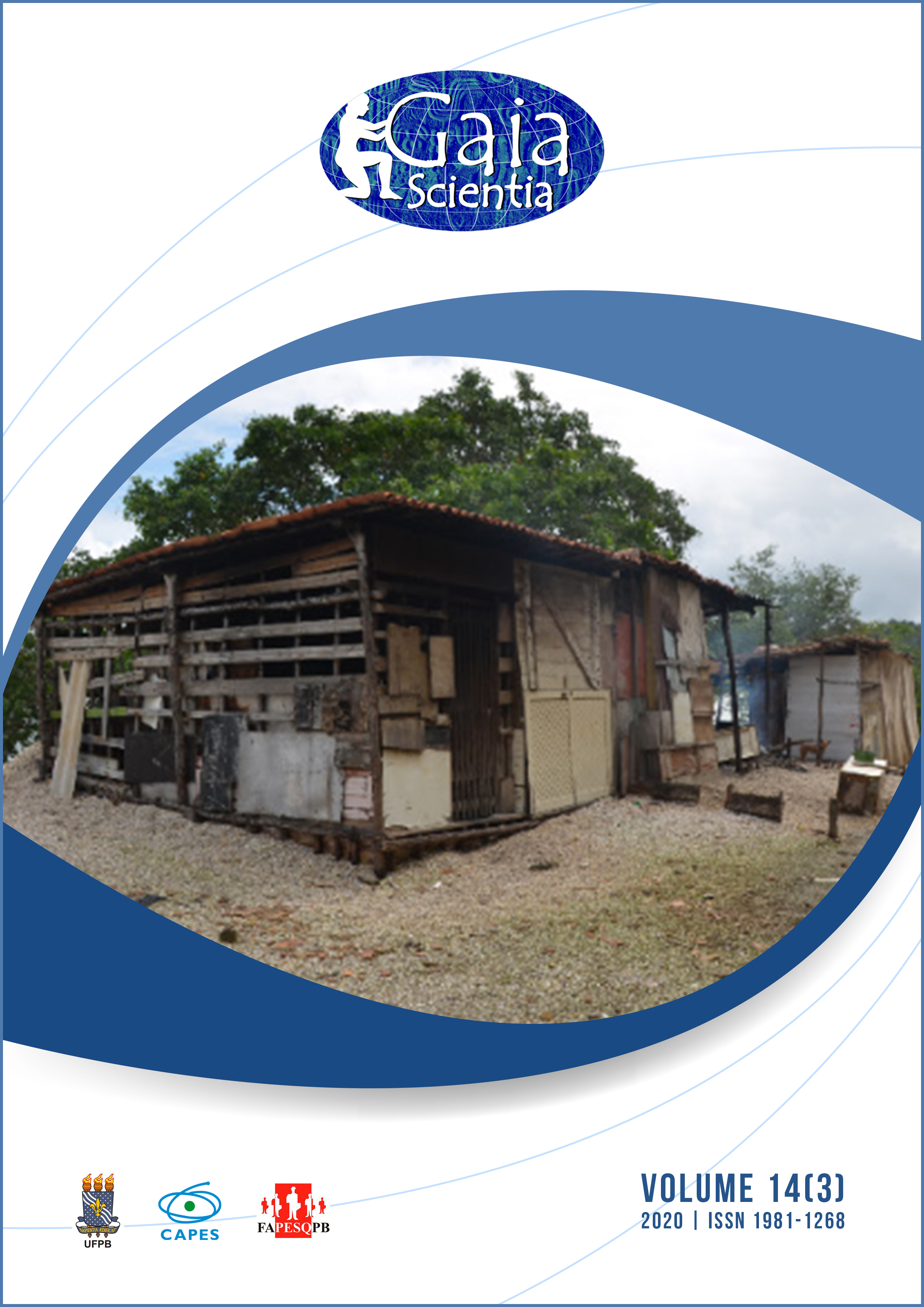Estimates of aboveground biomass and wood volume in Sabiá (Mimosa caesalpiniifolia Benth.) stands
DOI:
https://doi.org/10.22478/ufpb.1981-1268.2020v14n3.47229Abstract
Mathematical models produced from dendrometric relationships that use the diameter at breast height (DBH) and height can be an alternative to estimate the biomass and wood volume of individuals and forest stands, which is useful for forest management. Thus, we aim to adjust mathematical models to estimate the humid aerial biomass and the wood volume of a Sabiá stand. To do this, we made the cubage of the humid aboveground biomass and the volume at commercial and total height. We used DBH and height as predictor variables, according to the requirements of each equation. The choice of the best equation was based on adjusted R2, on the normality of the residues, on their graphical distribution and on the standard error of the estimate (Syx%). The biomass model = 7.134411743986 + 0.218501385492548 *DAP2 was the most suitable for the adjusted biomass data. The best equations for estimating the volume at commercial height and total height were respectively: V = 0.0042493278498619 + 0.0000322813042346465*(DAP2*Hcommercial) and V = 0.00404929514539746 + 0.0000278267926885885*(DAP2*Htotal). The height was a variable that contributed to the improvement of the models to estimate the volume, however, it did not produce improvements in the models to estimate humid aerial biomass.
Downloads
References
Alencar FHH. 2011. Resistência natural da madeira de sabiá (Mimosa Caesalpiniifolia Benth.) a cupins subterrâneos. Revista Caatinga, 24(1): 57-64.
Araújo LVC, Leite JAN, Paes JB. 2004. Estimativa da produção de biomassa de um povoamento de jurema-preta (Mimosa tenuiflora (WILLD.) POIRET. com cinco anos de idade. Biomassa & Energia, 1(4): 347-352.
Barros BC, Silva JAA, Ferreira RLC, Rebouças ACMN. 2010. Volumetria e sobrevivência de espécies nativas e exóticas no polo gesseiro do Araripe, PE. Ciência Florestal, 20(4): 641–647. Disponível em: <https://periodicos.ufsm.br/cienciaflorestal/article/view/2422>
Barreto TNA, Silva JAA, Ferreira RLC, Almeida CCS. 2018. Ajuste de modelos matemáticos à biomassa seca dos compartimentos de plantas lenhosas em área de caatinga. Scientia Forestalis, 46 (118): 285-295. Doi: http://dx.doi.org/10.18671/scifor.v46n118.14.
Brianezi D, Jacovine LAG, Soares CPB, Castro RVO, Basso VM. 2013. Equações alométricas para estimativa de carbono em árvores de uma área urbana em Viçosa – MG. Revista Árvore, 37 (6): 1073-1081. Doi: http://dx.doi.org/10.1590/S0100-67622013000600009
Bussab WO, Morettin PA. 2017. Estatística básica. São Paulo: Saraiva, 554p.
Campos JCC, Leite HG. 2002. Mensuração Florestal: perguntas e respostas. Viçosa: Editora UFV, 407 p.
Climate-date.Org. Dados climáticos para cidades mundiais. 2017. Disponível em: ˂https://pt.climate-data.org/america-do-sul/brasil/rio-grande-do-norte-216/?page=7˃. Acesso em: 01 maio. 2019.
Dalla Lana M, Ferreira RLC, Silva JAA, Duda GP, Lins e Silva Brandão CF, Da Silva AF. 2018. Biomass Equations for Caatinga Species. Nativa, 6(5): 517–525. Doi: http://dx.doi.org/10.31413/nativa.v6i5.5361
De Lima RB, Alves Júnior FT, De Oliveira CP, Silva JAA, Ferreira RLC. 2017. Predicting of biomass in Brazilian tropical dry forest: a statistical evaluation of generic equations. Anais da Academia Brasileira de Ciencias, [s. i.], v. 89, n. 3, p. 1815–1828. Doi: http://dx.doi.org/10.1590/0001-3765201720170047
Ferraz JS F, Ferreira RLC, Silva JAA, Meunier IMJ, Santos MVF. 2014. Estrutura do componente arbustivo-arbóreo da vegetação em duas áreas de Caatinga, no município de Floresta, Pernambuco. Revista Árvore, 38 (6):1055-1064.
Disponível em: http://www.scielo.br/pdf/rarv/v38n6/a10v38n6.pdf
Herrera MEF. 1989. Densidade básica e equações de peso de madeira seca de povoamentos de eucalipto de acordo com a idade, espécie e método de regeneração. Dissertação (Mestrado em Ciência Florestal) – Universidade Federal de Viçosa. Viçosa: UFV. 113f.
Husch B, Miller CI, Beers TW. 1972. Forest mensuration. 3.ed. New York: The Ronald Press, 402 p.
Ibge – Instituto Brasileiro de Geografia e Estatística. 2012. Manual técnico da vegetação Brasileira. Rio de Janeiro: Ibge, 271p.
Idema – Instituto de Desenvolvimento Sustentável e Meio Ambiente do Rio Grande do Norte. 2008. Perfil do seu município: Upanema-RN. Natal: Idema. Disponível em: ˂ http://adcon.rn.gov.br/ACERVO/idema/DOC/DOC000000000013802.PDF˃. Acesso em: 11 de maio de 2019.
Köppen W. 1996. Sistema geográfico dos climas. Notas e Comunicado de Geografa - Série B: Textos Didáticos n° 13. Recife: Editora Universitária UFPE, 31p.
Maia GN. 2012. Caatinga: árvores e arbustos e suas utilidades. 2. ed. Fortaleza: Printcolor Gráfica e Editora, 413 p. il.
Ribeiro Júnior JI. 2013. Análises estatísticas no Excel: guia prático. Viçosa: Editora UFV.
Schumacher FX, Hall FS. 1933. Logarithmic expression of timber volume. Journal of Agricultural Research, 47 (9):719-734.
Disponível em: <https://naldc.nal.usda.gov/download/IND43968352/PDF>
Sampaio EVSB, Silva GC. 2005. Biomass equations for Brazilian semiarid caatinga plants. Acta Botanica Brasilica, 19 (4): 935–943. Doi: http://dx.doi.org/10.1590/S0102-33062005000400028
Sampaio EVSB; Gasson P, Baracat A, Cutler D. Pareyn FGC, Lima KC. 2010. Tree biomass estimation in regenerating areas of tropical dry vegetation in northeast Brazil. Forest Ecology and Management, 259 (6): 1135–1140. Doi: http://dx.doi.org/10.1016/j.foreco.2009.12.028
Santana OA. 2017. Minimum age for clear-cutting native species with energetic potential in the Brazilian semi-arid region. Canadian Journal of Forest Research, 47 (3): 411–417. Doi: http://dx.doi.org/10.1139/cjfr-2016-0392
Santos RC, Castro RVO, Carneiro ADCO, Castro AFNM, Pimenta AS, Pinto EM, Marinho IV. 2016. Estoques de volume, biomassa e carbono na madeira de espécies da Caatinga em Caicó, RN. Pesquisa Florestal Brasileira, 36 (85): 1-7. Doi: http://dx.doi.org/10.4336/2016.pfb.36.85.772
Silva JA. 2005. Fitossociologia e relações alométricas em caatinga nos estados da Paraíba e Rio Grande do Norte. Tese (Doutorado em Ciência Florestal) - Universidade Federal de Viçosa. Viçosa: UFV, 93 f.
Silva GC, Sampaio EVSB. 2008. Biomassas de partes aéreas em plantas da caatinga. Revista Árvore, 32 (3): 567–575. Disponível em:
<http://www.scielo.br/scielo.php?script=sci_arttext&pid=S0100-67622008000300017&lng=pt&tlng=pt>
Spurr SH. 1952. Forest inventory. New York: The Ronald Press Company, 476p.
Soares CPB, Martins FB, Leite Junior HU, Silva GF, Figueiredo LTM. 2011. Equações hipsométricas, volumétricas e de taper para onze espécies nativas. Revista Árvore, 35 (5):1039-1051. Doi: http://dx.doi.org/10.1590/S0100-67622011000600010
Souza PF, Silva JA, Lucena DS, Santos WS, Henriques IGN, Lucena MFA, Souza AD. 2016. Estudos fitossociológicos e dendrométricos em um fragmento de Caatinga, São José de Espinharas-PB. Ciência Florestal, 26 (4): 1317–1330. Disponível em: <https://periodicos.ufsm.br/cienciaflorestal/article/view/25152/pdf>
Thomas C, Andrade CM, Schneider PR, Finger CAG. 2006. Comparação de equações volumétricas ajustadas com dados de cubagem e análise do tronco. Ciência Florestal, 16 (3): 319-327.
Disponível em: < https://periodicos.ufsm.br/cienciaflorestal/article/view/1911>
Vital BR. 1984. Métodos de determinação da densidade da madeira. Viçosa: Sociedade de Investigações Florestais, Boletim Técnico 1, 21 p.










